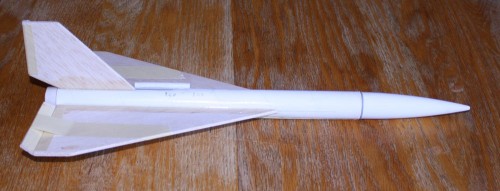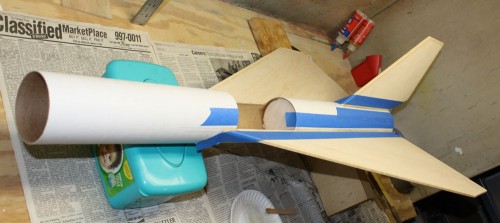Over the last few weeks I’ve posted a bunch of updates to catch up this blog on the status of my GPS-guided rocket recovery project.
At this moment (September 2011), it seems that the main problem I’ve been having with getting the parachute to steer properly is twisting of the control lines (see previous posts). I probably should have figured it out earlier, but the problem didn’t become totally clear until I could see it happening with the on-board 808 keychain camera. I’d been misled by the results of flight #28 way back in July 2010, which seemed to work OK with a tiny 2.5″ baseline – but it seems that was just luck.
Before my next flight, I plan to redesign and rebuild the steering system so that it has a much larger baseline. The comment by Tom Hannan posted July 29 on the project page hits the nail on the head, I think – the GPS and steering mechanism needs to be mounted right at the pivot point of the parachute, not any further down. This should cut way down on the swinging. I’ll try to make the parachute lines much harder to tangle while I’m at it. I also need to implement a apogee-detect lockout for a few seconds after launch (to avoid the problems in my last flight, on July 24). I’m not sure when that will be ready – probably October/November.
At the same time, I’ve been working with fellow CMASS rocketeer Boris Katan on a closely-related project – a rocket glider with GPS-steered recovery, based on the same electronics and software. We started back in June or so. At that time I thought the main problem with the system was swinging of the GPS under the long parachute lines – the GPS could conceivably be swinging in one direction while the parachute flew in another, which would certainly confuse my navigation algorithm. Also, I knew then that I had lots of problems with line tangling preventing reliable parachute deployment. Boris suggested that a rocket glider might be a way to test the navigation system without the complexities of the parachute – no long lines and swinging, and no tangling.
I thought it was a great idea, and we agreed to work on it together – Boris is building the airframe of the rocket glider, and I’ll be installing my electronics and servos into it to steer it. Boris started a thread on The Rocketry Forum about the project – there’s lots of info there.
Boris first built a 1/3 scale model of the final glider – here it is before flight:
This flew twice on August 11 – both times fine, proving the stability of the design (see the TRF thread for more details). Now he is building the full-scale glider – here’s a recent picture from Boris – you can see the hole in the 3″ body tube for the electronics bay:
The delta-wing glider will steer with two elevons, using two servos to drive it. This will give us both yaw and pitch control, so we can flare the glider as well as steer it left/right. The elevons will be set flat (minimum drag) for the rocket boost. Then after apogee the nav system will try to steer it back to the pad. When the glider gets close to the ground (100 feet AGL or so), it will flare (to minimize airspeed) and deploy a parachute for a soft landing. I’ll be building up a new set of electronics to go in the glider, and working on some minor changes to the way the servos are driven in software, to allow both pitch and yaw control. We’re aiming for a first test flight on October 22 – but no promises.
The other day I got an email from Mike Passaretti way down in Western Australia, who saw my project here, and is working on a similar one of his own. His very first test flight was last weekend. Mike seems like a very experienced engineer, and I think has a good approach. There’s a very interesting thread on his project on the Australian Rocketry Forum. Maybe we’ll have a chance to collaborate – that would be fun.
Now that I’ve caught up the blog, I can go back to work. Watch this space.


#1 by Gary on 2014 May 24 - 22:29
Quote
Um…You are aware that in the USA and in Canada this project is considered a “Drone” and as such is ILLEGAL don’t you?
“Active guidance” in a rocket during recovery phase is also against TRA etc. rules also.
#2 by Dave on 2014 June 2 - 23:00
Quote
I am aware that there is a popular belief to that effect, but I am not aware of any actual rules or regulations saying that.
Drones are not illegal in the US if used for hobby purposes (Google on “quadcopter autopilot”, for example).
The only applicable law I know of is 14 CFR 103, subpart C. I don’t see anything in there that looks like a problem. Do you?
If you know of any actual rules (state, federal, TRA, or NAR) to that effect, could you please point me at them? I’ve asked, and while many people think there is some rule prohibiting guidance, as far as I can tell, it is rumor and not fact.
Cheers,
–Dave